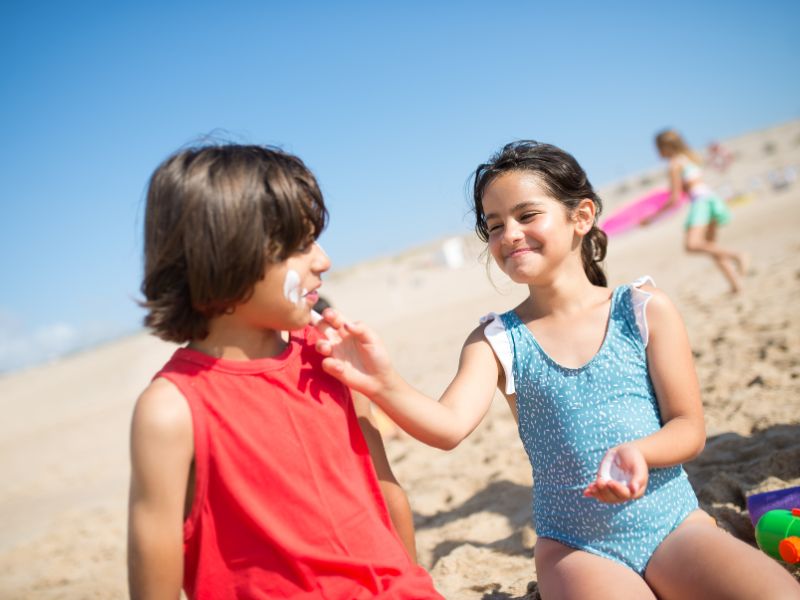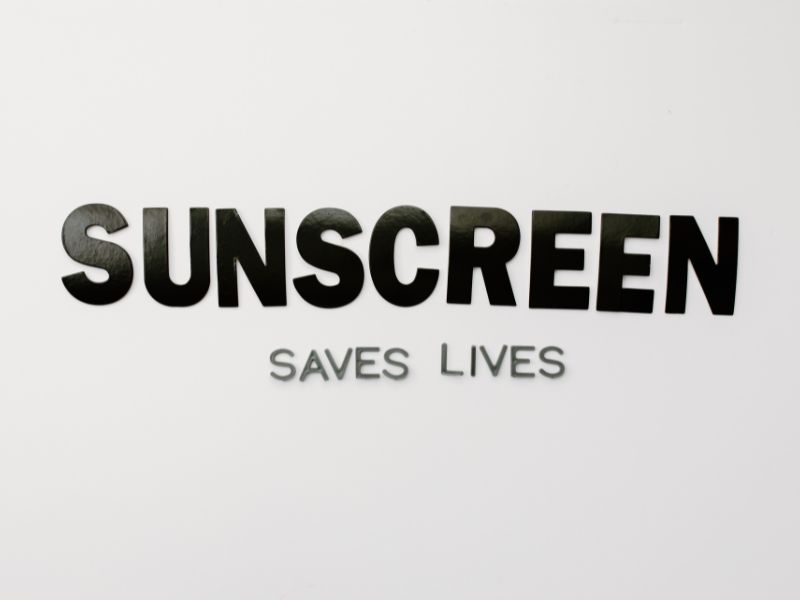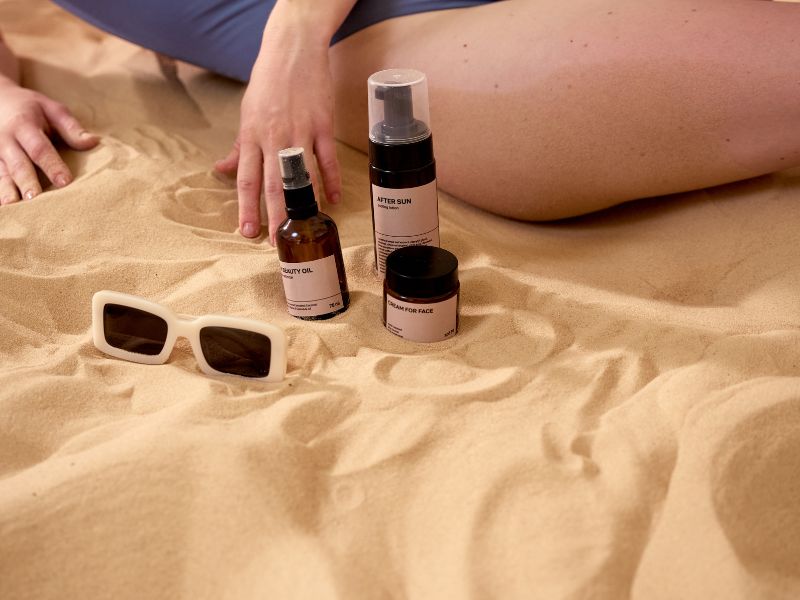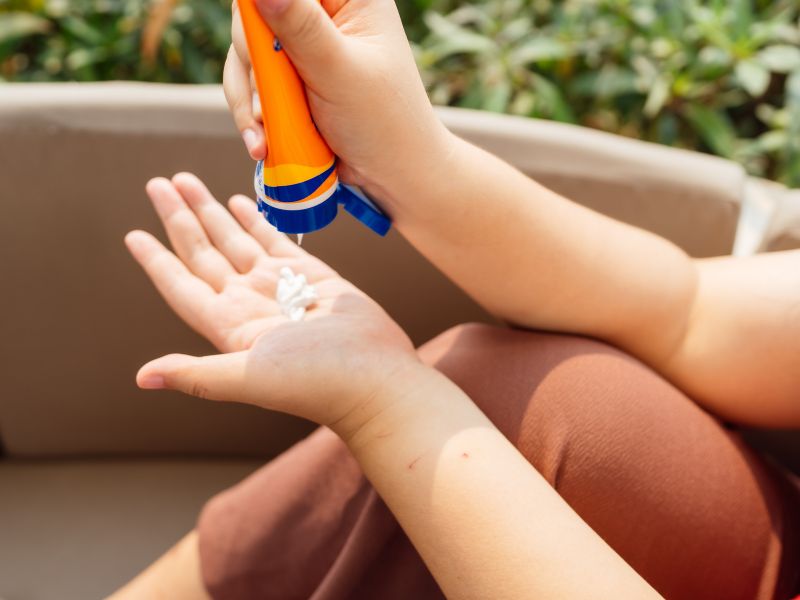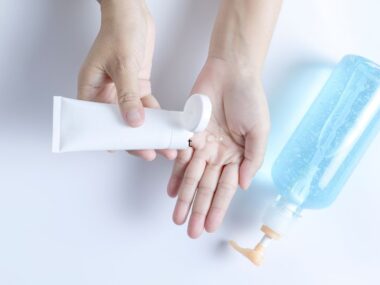Whether your child is playing in the garden, visiting the beach, or spending a summer day at the park, sunscreen is a crucial component of shielding their skin from damaging UV radiation. Children’s sunscreen is essential since their delicate skin is more vulnerable to UV harm than an adult’s. However, choosing the right sunscreen for your child may be difficult with so many alternatives available. Everything you need to know about sunscreen for kids is covered in this article, including why it’s important, how to pick the best product, and application advice.
Table of Contents
ToggleWhy Is Sunscreen Important for Kids?
Even in young children, the sun’s ultraviolet (UV) radiation can raise the risk of skin cancer and cause serious skin damage. Because their skin is more sensitive and lacking the melanin that helps filter UV rays, children are more vulnerable to sunburn. Early-life sunburns can quadruple the chance of developing melanoma later in life, according to the Skin Cancer Foundation. Additionally, using sunscreen helps prevent long-term skin damage, which can lead to pigmentation problems and premature aging, in addition to avoiding sunburns.
A sunscreen designed specifically for children can better satisfy their individual needs because their skin requires greater protection than that of adults..
Understanding UV Radiation and SPF
Before selecting a sunscreen, it helps to understand the basics of UV radiation and SPF ratings.
- UV Radiation: The sun emits two types of UV radiation that reach the earth—UVA and UVB. UVB rays are responsible for sunburn, while UVA rays penetrate deeper and can cause skin aging and cancer. The best sunscreen will provide broad-spectrum protection, meaning it shields against both UVA and UVB rays.
- SPF (Sun Protection Factor): SPF is a measure of how well a sunscreen will protect against UVB rays. For example, an SPF of 30 means that it would take 30 times longer for the skin to burn than it would without any protection. Generally, an SPF of 30 to 50 is recommended for children. Anything below SPF 30 may not provide enough protection, while SPF ratings higher than 50 often offer minimal additional protection.
Types of Sunscreen: Mineral vs. Chemical
Sunscreens can be categorized as either mineral (physical) or chemical based on their active ingredients.
- Mineral Sunscreen: Mineral sunscreens, also known as physical sunscreens, contain active ingredients like zinc oxide or titanium dioxide that sit on top of the skin and reflect UV rays. Mineral sunscreens are often recommended for children because they are less likely to irritate sensitive skin and start working immediately upon application.
- Chemical Sunscreen: Chemical sunscreens absorb into the skin and work by absorbing UV rays, converting them into heat, and then releasing that heat from the skin. They contain ingredients like oxybenzone, avobenzone, and octinoxate. While effective, chemical sunscreens can sometimes cause irritation, especially for kids with sensitive skin.
Choosing the Best Sunscreen for Kids
When choosing a sunscreen for kids, there are several factors to consider:
- SPF Level: Choose a sunscreen with an SPF of at least 30 but not necessarily higher than 50, as higher SPFs can sometimes be more irritating to sensitive skin.
- Broad-Spectrum Protection: Ensure the sunscreen offers broad-spectrum protection to shield against both UVA and UVB rays.
- Formulation Type: Opt for mineral-based sunscreens when possible, as they tend to be gentler on young skin.
- Water-Resistance: Kids love to splash around, so a water-resistant formula is essential, especially if they’re swimming or sweating. Water-resistant sunscreens usually last for 40 to 80 minutes, so reapplication is key after this time.
- Hypoallergenic and Fragrance-Free: Look for sunscreens labeled as hypoallergenic and fragrance-free to avoid irritation. Children’s skin is sensitive, and strong fragrances or chemical ingredients can cause reactions.
- Ease of Application: Sunscreen is available in several forms, including lotions, sticks, and sprays. Stick sunscreens are convenient for applying to the face, while sprays can cover large areas quickly. However, with sprays, be careful to avoid inhalation and to rub it in for even coverage.
Top Recommended Sunscreens for Kids
Blue Lizard Australian Sunscreen – SPF 30+ (Mineral)
- This mineral sunscreen contains zinc oxide and titanium dioxide, which provide gentle protection. It’s water-resistant for up to 80 minutes and doesn’t contain any parabens, fragrances, or irritants, making it suitable for sensitive skin.
Neutrogena Pure & Free Baby Mineral Sunscreen SPF 50
- Neutrogena’s mineral sunscreen is designed for delicate skin and is free of chemicals and parabens. It’s a broad-spectrum SPF 50 sunscreen that is also tear-free, which means it won’t cause eye irritation.
Thinkbaby Safe Sunscreen SPF 50+
- This popular mineral-based sunscreen is designed specifically for babies and children. It’s SPF 50+, water-resistant for up to 80 minutes, and free of harmful chemicals, making it one of the safest options on the market.
Badger Kids Mineral Sunscreen SPF 40
- Badger Kids is a certified organic sunscreen that contains zinc oxide as the active ingredient. It’s unscented, non-nano, and designed to be gentle on sensitive skin. This product is water-resistant for 40 minutes.
Aveeno Baby Continuous Protection Sensitive Skin Zinc Oxide Sunscreen SPF 50
- This mineral-based sunscreen is fragrance-free and made with oats and zinc oxide for sensitive skin. It offers broad-spectrum SPF 50 protection and up to 80 minutes of water resistance.
How to Apply Sunscreen on Kids: Tips and Tricks
Applying sunscreen can sometimes be a challenge, especially with younger children who may find the process uncomfortable. Here are some tips for successful application:
- Apply Generously and Evenly: It’s essential to apply enough sunscreen to cover all exposed skin. The general rule is about an ounce (a shot-glass size) for the whole body. Don’t skimp, as inadequate application can reduce effectiveness.
- Reapply Every Two Hours: Sunscreen wears off over time and with water exposure. Reapply every two hours or immediately after swimming or excessive sweating.
- Cover All Exposed Areas: Don’t forget about areas like the back of the neck, ears, hands, feet, and even the scalp for children with thin or short hair. Lip balms with SPF are also available for protecting lips.
- Use Sunscreen Sticks for the Face: A sunscreen stick can be a more convenient option for applying on a child’s face, especially around the eyes, as it’s less likely to run and cause stinging.
- Let Kids Participate: Kids may be more cooperative if they are involved in the process. Let them hold the bottle or apply it to their arms. Teaching them about sunscreen use can make it a more enjoyable habit.
Safety Tips for Kids With Sunscreen
While sunscreen is a powerful tool in sun protection, it’s best to use it in combination with other sun safety practices:
- Dress Appropriately: Long-sleeved shirts, hats with wide brims, and sunglasses can offer additional protection. Look for UV-protective clothing that provides better defense against UV rays than regular fabrics.
- Seek Shade: Limit sun exposure, especially between 10 a.m. and 4 p.m., when the sun’s rays are strongest. Opt for shaded areas during outdoor activities.
- Set a Good Example: Kids are more likely to follow good sun-safety habits if they see adults doing the same. Show them that protecting their skin is important.
- Be Consistent: Practice sun safety every day, not just on sunny summer days. UV rays can penetrate through clouds, and sun damage can occur year-round.
FAQs About Sunscreen for Kids
Q: Can I use my sunscreen on my child?
Yes, generally speaking, although it’s preferable to use sunscreen made especially for children, particularly if your sunscreen contains potentially irritating components. Sunscreens for kids are made to be kind to delicate skin..
Q: What if my child has a sunscreen allergy?
A pediatric dermatologist should be seen if your kid has an allergy. Avoid sunscreens with scents and preservatives and choose ones with mineral elements instead. Prior to a complete application, test on a little piece of skin..
Q: Is it safe to use sunscreen on infants?
Sunscreen is typically not recommended for infants less than six months. Instead, shield them from the sun, keep them in the shade, and wear protective clothes. See your pediatrician about applying a tiny bit to exposed areas if required..
Conclusion
A crucial first step in guaranteeing children’s safety and long-term skin health is selecting the appropriate sunscreen for them. Knowing the components, SPF values, and application techniques can help you make decisions that will protect your child’s skin. To provide your children the best resistance against damaging UV rays, combine sunscreen with additional preventative measures like wearing UV-protected clothes and looking for shade. Remember that a lifetime of protected, glowing skin is built on good sun habits formed during infancy.
